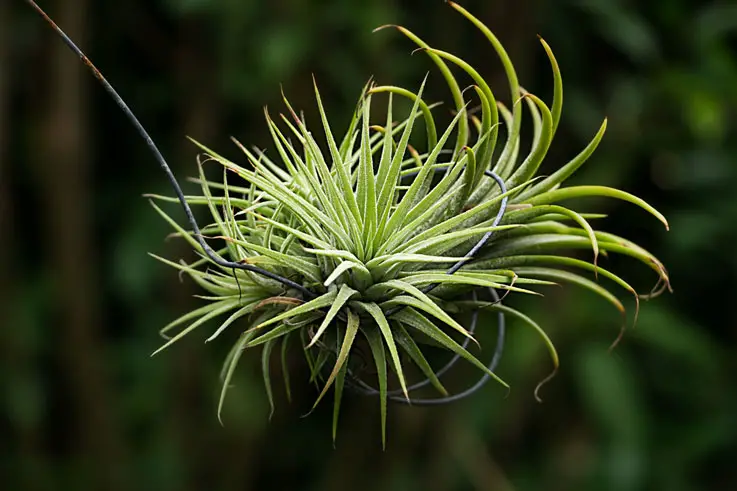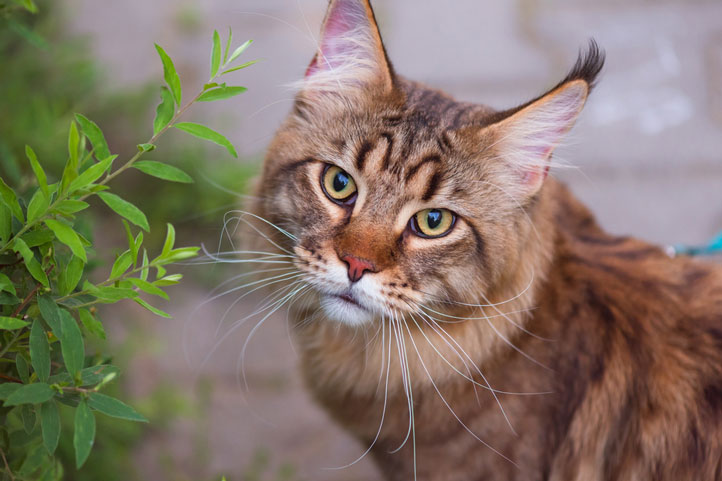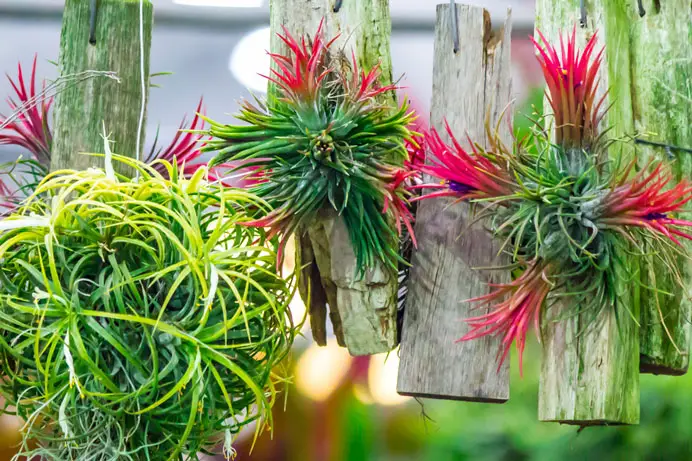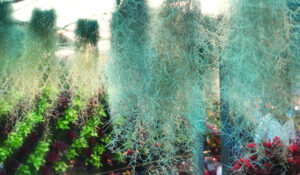Are Air Plants Toxic to Cats?

This post follows our research editorial guidelines.

Elegant, refined, and just a bit weird – all words that describe an air plant(Tillandsia) and a cat in equal parts. I love both my furry friends and the spiky Tillandsias that decorate the well-lit corners of my home. But how do we keep them safe from each other? Will my air plants poison my cat? And what about the Tillandsia?
Air plants are non-toxic, and contain no hazardous chemicals. That said, cats should not be allowed to eat air plants, as the tough material of their leaves can cause irritation and digestive upsets. Keep them apart and both will thrive.

Table of Contents
Air plants are a type of bromeliad, hailing from Central and South America . They tend to be small and rootless, no more than six or seven inches tall. They’re a perfect plant for apartments and small homes, as they don’t take up much space and are pretty easy to take care of. Just like cats, really! It’s easy to see how the two could come into contact.
Do cats like air plants?
Air plants have no specific features that attract cats. They really don’t have a fragrance, and their leaves are unappealing to chew. They’re just there, hanging out in the same space, not doing much to catch they eye of your feline friend.
But cats can be strangle little fluff-balls, and I can certainly see a more playful cat deciding that the air plant looks like an entertaining toy. The more bulbous varieties, with their long almost tentacular leaves, always make me thing of sea creatures and climbing insects, so I can see how appealing they may be to a curious kitty. And unlike almost all other houseplants, if the cat pounces or swats an air plant it’ll fly away most entertainingly, rolling or bouncing about. Your cat may not want to eat them, but they may well book in a full afternoon of play with your poor air plant instead.
Can air plants harm cats?

Air plants as a whole are non-toxic and have not been known to harm cats or other household pets. Air plants don’t release any hazardous pollen from their flowers, or attract insects that might attack your cat. They don’t have thorns, barbs or any other physical traits that could cause injury. And most importantly, they are non-toxic, with no poisonous components at all.
But because air plants are not poisonous, doesn’t mean they can’t hurt your cat. It’s still a good idea to keep them apart. Cats are obligate carnivores, to their digestion is primed for meat and meat alone. While cats do on occasion enjoy a sneaky nibble of grass or other foliage, it’s not really something they’re wired to eat in large quantities.
This is doubly true for a wiry, tough leafed plant like a Tillandsia. Their leathery leaves are especially hard to digest, and your cat’s body really isn’t ready to deal with that particular kind of plant material. The chances are good that they’ll wind up with a stomach ache if they really get stuck into your air plants.
That said, the odd nibble here and there won’t hurt your cat. It’s not great for the Tillandsia, though, so you’d do well to just get the cat its own toys and call it a day.

Can cats harm air plants?
While the air plant is unlikely to hurt your air plant, the reverse is not true. A cat’s sharp teeth and claws can cause substantial damage to your air plant. They evolved to sit up in trees or rock faces, just chilling – not engaging in extended wrestling matches with small predators.
Nibbled leaves and punctures or scratches from claws will cause lasting damage tor your air plant. Once wounded, the air plant is at risk of infection from malignant fungi and bacteria. And even if they heal without fuss, those scars are permanent. And eaten leaves can’t do much to help the air plant grow!
It’s just best all round to keep your air plant and your cat apart. There’s lots of fun ways to display a Tillandsia that can protect them from unruly pets. Glass cloches and terrariums will keep curious claws away from the air plant while allowing lots of light to reach the plant. Even a large jar will do in a pinch. Just be sure to take the Tillandsia out to water it now and then.
What are the most toxic house plants to cats?
Lilies are without a doubt the most toxic house plant to cats. No matter how much you adore their fragrance or elegant blooms, lilies can kill your cat almost effortlessly and should be kept clear of your pet.
All flowering lilies from the Lilium genus as well as the Day-lilies of the Hemerocallis genus contain chemicals that will cause massive kidney failure in cats, no matter how tiny an amount they ingest. Every part is toxic, and even the water in the lily’s vase quickly becomes dangerously poisonous. Peace lilies, callas and other lily types have their own dangers, causing digestive problems or damage the heart.

If you live with cats, never have lilies in the home. Regardless of how out of reach you think they may be, it’s just not worth the risk. Cats jump, dead leaves fall, vases spill, and pollen travels on breezes – any of these scenarios can kill your cat.
Dr. Jason Nicholas, vetinarian
Regrettably, a lot of other common houseplants are toxic to cats. Many are ‘easy-care’ plants, so are given to new plant enthusiasts by otherwise well meaning friends. While not as serious as lilies, they’re still dangerous to your cat. They include:
- Jade: Contains dangerous chemicals in their leaves.
- Pothos: Causes irritation and poisoning if ingested.
- Monstera deliciosa: Calcium oxalate in leaves burns delicate tissue.
- Diffenbachia: Also called dumbcane, all parts are poisonous.
- Sago Palm: Particularly toxic, it can cause nerve damage, kidney failure and digestive distress.
- Snake Plant: This common plant contains compounds in the leaf that causes irritation to the throat, eyes and mouth and can cause digestive upsets.
- Chrysanthemum: A host of toxins in the leaves can cause kidney and heart problems in addition to vomiting.
If you’ve got a kitty that loves nibbling things they shouldn’t, it’s always a good idea to check before bringing a new plant home. There are hundreds of common houseplants that are toxic to cats, so check with a reputable source before bringing a new plant home.

Are air plants poisonous to people or other animals?

It’s not just cats who are safe around air plants – they are non-toxic to other mammals like dogs, rabbits, and gerbils.
Horses apparently love to eat the air plant Spanish Moss (Tillandsia usneoides) and it’s sometimes used in the South as a cattle feed. Smaller varieties are used to decorate reptile and amphibian terrariums too, a testament to their non-toxic nature as both types of pet are very vulnerable to poisoning.
Final thoughts
Cats and air plants are alike in a lot of ways. They both are elegant, fuzzy treasures that are well suited to indoor lifestyles with the right care. They’ll do fine living together, provided the cat can keep their claws and teeth to themselves.
